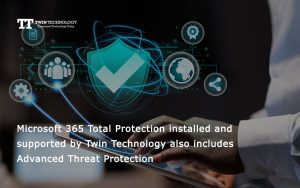With businesses now focussed on the path to recovery, following the disruptions of the COVID-19 pandemic, it is more important than ever to ensure company security policies are stringent and robust. Having suitable security in place is critical to everyday business operations. Despite this need, however, small- and medium-sized businesses are suffering at the hands of an increasingly remote workforce, a shortage of skills and time to overcome security risks, and a security landscape that is growing ever more complex.
In this first blog, in a two-part article series, we explore three key cybersecurity threats impacting businesses in the modern workforce setting – led by the proliferation of remote working and the widening skills gap for specialised IT professionals.
The threat landscape is growing and becoming more complex
Companies understand that securing their data is a critical undertaking. The cybersecurity threat landscape is increasing continually, and a growing workforce of remote workers adds further complexity. Despite understanding the need for robust security, many IT teams are not adequately protecting their endpoints, such as mobile devices and IoT devices. As the number and type of endpoints open to lateral movement from cyber attackers increases, so too does the risk.
In fact, according to a new report from Forrester Consulting, 34% (more than one-third) of respondents experienced a compromise of company data involving lateral movement, a homeworker device, or an overall increase in security incidents in the last year alone.
With the rate of cyberattacks rising, are businesses doing enough to protect themselves and their data? The report identifies that only 66% of respondents said they are securing employee-owned devices, while only 64% are securing IoT devices like IoT printers. This number must increase and greater import put on cybersecurity at all levels of the company. Attackers are becoming savvier; organisations cannot risk being left behind and vulnerable in the modern age.
A shortage of skills and time is impacting the small- and medium-sized business market
Cybersecurity skills are specialised and the skills gap in this remit is widening. Small- to medium-sized businesses face a conundrum – do they hire the right staff at inflated cost (staff with these skills are harder to find and demand a higher salary) or do they maintain an IT force that risk operating (in the face of the rising number of cybersecurity attacks) more reactively rather than proactively?
In fact, according to HP’s eBook, 85% of organisations report a shortage of cybersecurity skills.
Businesses should look to either hiring the right staff or upskilling their current workforce to be able to meet the demands of cybersecurity today. Looking to an IT support partner can also be a vital way to bring the right skills to your organisation and defend against the rising number of attacks.
The remote workforce explosion in a post-Covid world is contributing to cybersecurity threats
The modern workforce has been turned on its head, making it harder for security leaders to cope with the growing demand for accessibility to sensitive corporate data outside of the traditional security scope, mainly via mobile devices. At the same time, these security gaps are being exploited by attackers.
The widespread security challenges resulting from the staff themselves are even more concerning, such as security being a hindrance to productivity or remote workers feeling uncomfortable with having security controls placed on them at home. A recent HP-sponsored study around remote workforce security trends, conducted by Toluna, highlights that 83% of IT teams surveyed believe the increase in home workers has created a “ticking time bomb” for a corporate network breach.
Despite this, remote working throws up several severe obstacles to defusing this time bomb:
- 80% of IT teams experienced objections from users who do not like controls being put on them at home
- 83% of IT teams said trying to set and enforce corporate policies around cybersecurity is impossible because the lines between personal and professional lives are blurred.
- 69% of IT teams said they are made to feel like the “bad guys” for imposing restrictions.
IT teams require more drive from business executives alongside simple, manageable solutions to instil the right security culture in their remote workers.
What can you do to overcome the challenges to empowering the modern workforce against cybersecurity threats?
In Part 2, we will explore how outsourcing the right managed IT support partner will help businesses to overcome these challenges, by:
- Securing the remote workforce from cyberthreats, phishing attacks, unpatched vulnerabilities, data loss and other exposures in an ever increasing threat landscape.
- Monitoring, managing, and securing employees’ mobile devices.
- Keeping sensitive information in email communication and accounts secure.
- And much more!
Want to speak to someone now? Not a problem, request a consultation with our IT Security experts to discover more





